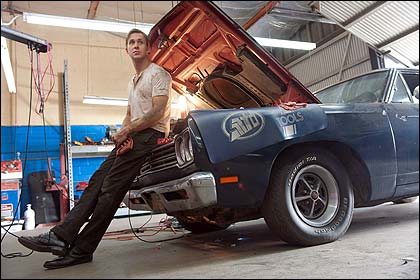
Driven to Extremes
Ryan Gosling centers a violent fairytale
by Molly Templeton
DRIVE: Directed by Nicolas Winding Refn. Written by Hossein Amini, based on the novel by James Sallis. Cinematography, Newton Thomas Sigel. Editor, Mat Newman. Music, Cliff Martinez. Starring Ryan Gosling, Carey Mulligan, Bryan Cranston, Albert Brooks, Christina Hendricks, Ron Perlman and Oscar Isaac. FilmDistrict, 2011. R. 100 minutes. Three and a half stars.
 |
You might come to the conclusion, based on Nicolas Winding Refn’s last three movies, that the director has a knack for making smart, violent, fascinating films about characters with whom you would want to spend absolutely zero time. Tom Hardy’s turn as the title character in Bronson, about Britain’s most violent prisoner, was magnetic and cheerily horrifying, his mad laughter cutting off mid-syllable, transforming into a ferocious appreciation for violence. Refn’s Valhalla Rising is a bizarre Viking movie — sort of — which follows the mute, brutal One Eye (Mads Mikkelsen), a longtime prisoner who finds himself in a bloody New World.
Driver (Ryan Gosling), in Refn’s new film Drive, is a different kind of creature, though still one with a talent for violence. In an elegant opening sequence, Refn and screenwriter Hossein Amini, working from the book by James Sallis, set up their nameless lead as an efficient but distant man who has a nebulous relationship with the law. But holy shit, the kid can drive. He supplements his more traditional income from a job as a stunt driver with midnight capers in which he belongs to his clients for five minutes. No more, no less, no questions.
The driver, the kid — he’s nameless, lacking history, context, personality. He speaks in brief phrases that communicate only the most essential information and drives with a preternatural calm that’s as beautiful as it is disquieting. Even a detail that seems like a snippet of personal information turns into part of his exquisite plan; he’s not listening to the Clippers game because he cares about the outcome. But that’s not to say he’s heartless. Driver takes an interest in the pretty girl next door, Irene (Carey Mulligan, with too little to do), and her son, Benicio (Kaden Leos). Irene conspicuously wears a wedding ring but is quick to say yes when Driver, gnawing a toothpick and smiling an unreadable smile, asks if she wants to see something.
Drive is saturated with synth-pop and dotted with too-brief, tightly controlled car chase scenes. The initially incongruous soundtrack, by Cliff Martinez, is a wonder, an immersive thing that gives the film a dreamlike quality to match its sleek atmosphere and the pared-down quality of Gosling’s taut performance. A sweet, crystalline song that insists, “You have proved to be a real human being / and a real hero” plays as if only for Driver, the soundtrack to his triumph and his failures. Like a glossy pop song, Drive is on one level all style and flash, a meta-movie with a movie character for a lead, and on another a reflection of its time and influences — ’80s love stories, ’70s car movies, enigmatic antiheroes and the kind of person whose personal soundtrack says an awful lot about his emotional landscape.
Refn and Gosling have both spoken of Drive as a fairy-tale film, which explains the archetypal feel of the characters — the monsters, the princess, the hero — and the familiar elements of the violence-dappled and relatively thin plot. The princess character is unsurprisingly underdeveloped, but the hero, intriguingly, isn’t really anything of the sort. Driver sees himself as the hero when he sees Irene as needing his protection; he envisions and enacts a story in which he focuses all his effort on saving the girl and the day. Is the path he chooses that of a hero, or that of a sociopath? Is Drive another movie in which a relatively good, decent man takes a violent turn in order to do the right thing, or a commentary on the kind of man who idealized those stories? Plan your movie night with plenty of time to discuss this one with your friends afterwards.